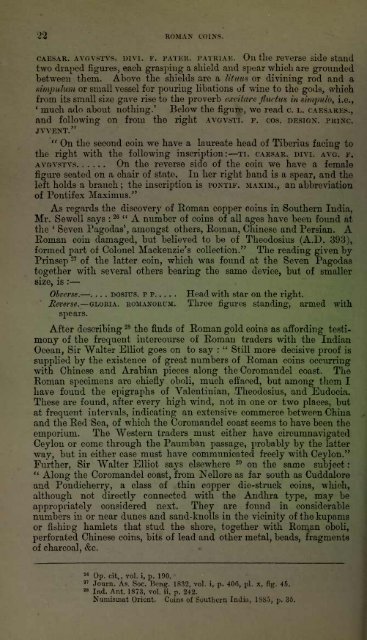Coins In Lucknow Mus. Vol 01 [56 MB - IndianCoins.org
Coins In Lucknow Mus. Vol 01 [56 MB - IndianCoins.org
Coins In Lucknow Mus. Vol 01 [56 MB - IndianCoins.org
Create successful ePaper yourself
Turn your PDF publications into a flip-book with our unique Google optimized e-Paper software.
2 ROMAN COINS.CAESAR. AVOVSTVS. Divi. F. PATKR. p.viRiAE. On tlie reverse side standtwo draped figures, each grasping a shield and spear which are groundedbetween them. Above the shields are a lituus or divining rod and asimpulum or small vessel for pouring libations of wine to the gods, whichfrom its small size gave rise to the proverb excitare fluctu* in xit/tpulo, i.e.,'much ado about nothing.' Below the figure, we read c. L. CAESARES.,and following on from the right AVGVSTI. F. cos. DESIGN. PRIXC.JVVENT."" On the second coin we have a laureate head of Tiberius facing tothe right with the following inscription: TI. CAESAR. DIVI. AVG. F.AVGVSTVS On the reverse side of the coin we have a femalefigure seated on a chair of state, <strong>In</strong> her right hand is a spear, and theleft holds a branch ;the inscription is PONTIF. MAXIM., an abbreviationof Pontifex Maximus."As regards the discovery of Roman copper coins in Southern <strong>In</strong>dia,26Mr. Sewell" says: A number of coins of all ages have been found atthe ' Seven Pagodas', amongst others, Roman, Chinese and Persian. ARoman coin damaged, but believed to be of Theodosius (A.D. 393),formed part of Colonel Mackenzie's collection." The reading given byPrinsep 27 of the latter coin, which was found at the Seven Pagodastogether with several others bearing the same device, but of smallersize, is :Obverse. . . . . BOSITJS. p p Head with star on the right.Reverse. GLORIA. ROMANORUM. Three figures standing, armed withspears.28After describing the finds of Roman gold coins as affording testimonyof the frequent intercourse of Roman traders with the <strong>In</strong>dianOcean, Sir Walter Elliot goes on to "say Still more decisive :proof issupplied by the existence of great numbers of Roman coins occurringwith Chinese and Arabian pieces along the Coromandel coast. TheRoman specimens are chiefly oboli, much effaced, but among them Ihave found the epigraphs of Valentinian, Theodosius, and Eudocia.These are found, after every high wind, not in one or two places, butat frequent intervals, indicating an extensive commerce between Chinaand the Red Sea, of which the Coromandel coast seems to have been theemporium. The Western traders must either have circumnavigatedCeylon or come through the Paumban passage, probably by the latterway, but in either case must have communicated freely with Ceylon."Further, Sir Walter Elliot says elsewhere 29 on the same subject:" Along the Coromandel coast, from Nellore as far south as Cuddaloreand Pondicherry, a class of thin copper die-struck coins, which,although not directly connected with the Andhra type, may beappropriately considered next. Theyare found in considerablenumbers in or near dunes and sand-knolls in the vicinity of the kupamsor fishirg hamlets that stud the shore, together with Roman oboli,perforated Chinese coins, bits of lead and other metal, beads, fragmentsof charcoal, &c.26Op. cit., vol. i, p. 190." Journ. As. Soc. Beng. 1832, vol. i, p. 406, pi. x, fig. 45.28 <strong>In</strong>d. Ant. 1873, vol. ii. p. 21:.'.Numisuwt Orient. <strong>Coins</strong> of Southern <strong>In</strong>dia, 188-5, p. 35.

















